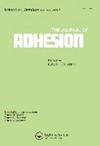Improvement of the bonding performance of sucrose and ammonium dihydrogen phosphate adhesive by addition of dephenolized cottonseed protein
IF 2.3
4区 材料科学
Q2 ENGINEERING, CHEMICAL
引用次数: 3
Abstract
ABSTRACT Research on adhesives made from recycled and renewable biomass materials is an important direction in wood material industry. The eco-friendly plywood adhesive named as SADP adhesive, according to its composition (Sucrose and Ammonium Dihydrogen Phosphate), developed in our research group previously has good bonding performance but bleed-through veneer. In previous studies, we found that plant proteins, such as defatted soybean flour (DSF) and dephenolized cottonseed protein (DCP) material could improve this phenomenon. However, although DCP considerably promoted the bonding performance of the SADP adhesive, DSF did not. Therefore, this study will determine the optimal preparation and hot pressing conditions of the developed adhesive, and investigate the curing mechanism. First, the evaluation of the effects of the plant protein type, mass ratio, hot pressing temperature and time on the bonding performance of these adhesives revealed that plywood prepared by hot pressing at 170°C for 7 min using DCP/SADP-1/3 ratio as adhesive had the highest wet shear strength (1.17 MPa). Additionally, the comparative analysis of the two plant proteins showed that the DCP has a higher crude protein content, more tryptophan and arginine, which might be the reason for its better bonding performance with SADP solution. Second, in the analysis of curing behavior, the result of TG-DSC analysis corresponded to the insoluble mass proportion measurement, indicating that the optimal curing temperature of DCP/SADP-1/3 adhesive was about 170°C. In addition, ATR FT-IR analysis indicated that the curing mechanism was complex, involving caramelization and Maillard reaction to form a dense crosslinking structure, with dimethylene ether bridge as the main linkage. Finally, a comparison of various scanning electron microscopy (SEM) chromatograms revealed that, with the increase of the amount of DCP added, the cured adhesive became less porous and had smoother surface, which further confirmed that DCP and SADP solution formed a novel network crosslinked structure after curing process. Furthermore, compared with the wet shear strength of SADP adhesive (0.88 MPa), the plywood prepared using the novel DCP/SADP-1/3 adhesive (1.17MPa) was increased by 33%.脱酚棉籽蛋白对蔗糖-磷酸二氢铵胶粘剂粘接性能的改善
摘要利用再生和可再生生物质材料制备胶粘剂是木材工业的一个重要方向。本课题组开发的环保型胶合板胶粘剂SADP胶粘剂,根据其成分(蔗糖和磷酸二氢铵),具有良好的粘接性能,但会渗透单板。在以前的研究中,我们发现植物蛋白,如脱脂大豆粉(DSF)和脱酚棉籽蛋白(DCP)材料可以改善这种现象。然而,尽管DCP显著提高了SADP粘合剂的粘合性能,但DSF却没有。因此,本研究将确定所开发的粘合剂的最佳制备和热压条件,并研究其固化机理。首先,评估了植物蛋白类型、质量比、热压温度和时间对这些粘合剂粘合性能的影响,结果表明,使用DCP/SADP-1/3比例作为粘合剂,在170°C下热压7分钟制备的胶合板具有最高的湿剪切强度(1.17MPa)。此外,对两种植物蛋白的比较分析表明,DCP具有更高的粗蛋白含量、更多的色氨酸和精氨酸,这可能是其与SADP溶液具有更好结合性能的原因。其次,在固化行为的分析中,TG-DSC分析的结果与不溶性质量比的测量结果相对应,表明DCP/SADP-1/3粘合剂的最佳固化温度约为170°C。此外,ATR FT-IR分析表明,固化机理复杂,包括焦糖化和美拉德反应形成致密的交联结构,以二甲醚桥为主要键。最后,通过对各种扫描电子显微镜(SEM)色谱图的比较表明,随着DCP添加量的增加,固化后的粘合剂变得不那么多孔,表面更光滑,这进一步证实了DCP和SADP溶液在固化过程后形成了一种新型的网络交联结构。此外,与SADP粘合剂的湿剪切强度(0.88MPa)相比,使用新型DCP/SAP-1/3粘合剂制备的胶合板(1.17MPa)提高了33%。
本文章由计算机程序翻译,如有差异,请以英文原文为准。
求助全文
约1分钟内获得全文
求助全文
来源期刊

Journal of Adhesion
工程技术-材料科学:综合
CiteScore
5.30
自引率
9.10%
发文量
55
审稿时长
1 months
期刊介绍:
The Journal of Adhesion is dedicated to perpetuating understanding of the phenomenon of adhesion and its practical applications. The art of adhesion is maturing into a science that requires a broad, coordinated interdisciplinary effort to help illuminate its complex nature and numerous manifestations.
 求助内容:
求助内容: 应助结果提醒方式:
应助结果提醒方式:


